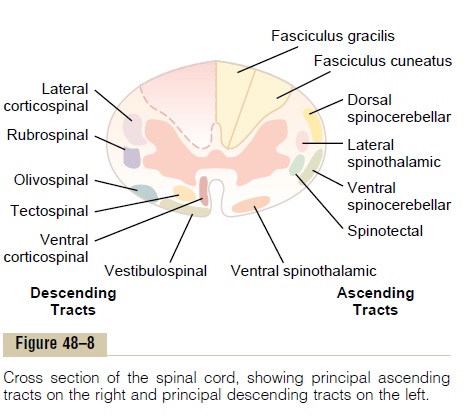Chapter: Medical Physiology: Somatic Sensations: II. Pain, Headache, and Thermal Sensations
Some Clinical Abnormalities of Pain and Other Somatic Sensations
Some Clinical Abnormalities of Pain and Other Somatic Sensations
Hyperalgesia
A pain nervous pathway sometimes becomes excessively excitable; this gives rise to hyperalgesia, which means hypersensitivity to pain. Possible causes of hyper-algesia are (1) excessive sensitivity of the pain receptors themselves, which is called primary hyperalgesia, and (2) facilitation of sensory transmission, which is called secondary hyperalgesia.
An example of primary hyperalgesia is the extreme sensitivity of sunburned skin, which results from sensitization of the skin pain endings by local tissue products from the burn—perhaps histamine, perhaps prostaglandins, perhaps others. Secondary hyperalgesia frequently results from lesions in the spinal cord or the thalamus. Several of these lesions are discussed in sub-sequent sections.
Herpes Zoster (Shingles)
Occasionally herpesvirus infects a dorsal root ganglion. This causes severe pain in the dermatomal segment sub-served by the ganglion, thus eliciting a segmental type of pain that circles halfway around the body.The disease is called herpes zoster, or “shingles,” because of a skin eruption that often ensues.
The cause of the pain is presumably infection of the pain neuronal cells in the dorsal root ganglion by the virus. In addition to causing pain, the virus is carried by neuronal cytoplasmic flow outward through the neu-ronal peripheral axons to their cutaneous origins. Here the virus causes a rash that vesiculates within a few days and then crusts over within another few days, all of this occurring within the dermatomal area served by the infected dorsal root.
Tic Douloureux
Lancinating pain occasionally occurs in some people over one side of the face in the sensory distribution area (or part of the area) of the fifth or ninth nerves; this phe-nomenon is called tic douloureux (or trigeminal neural-gia or glossopharyngeal neuralgia). The pain feels likesudden electrical shocks, and it may appear for only a few seconds at a time or may be almost continuous. Often it is set off by exceedingly sensitive trigger areas on the surface of the face, in the mouth, or inside the throat—almost always by a mechanoreceptive stimulus rather than a pain stimulus. For instance, when the patient swallows a bolus of food, as the food touches a tonsil, it might set off a severe lancinating pain in the mandibular portion of the fifth nerve.
The pain of tic douloureux can usually be blocked by surgically cutting the peripheral nerve from the hyper-sensitive area. The sensory portion of the fifth nerve is often sectioned immediately inside the cranium, where the motor and sensory roots of the fifth nerve separate from each other, so that the motor portions, which are needed for many jaw movements, can be spared while the sensory elements are destroyed. This operation leaves the side of the face anesthetic, which in itself may be annoying. Furthermore, sometimes the operation is unsuccessful, indicating that the lesion that causes the pain might be in the sensory nucleus in the brain stem and not in the peripheral nerves.
Brown-SĂ© quard Syndrome
If the spinal cord is transected entirely, all sensations and motor functions distal to the segment of transection are blocked, but if the spinal cord is transected on only one side, the Brown-Séquard syndrome occurs. The effects of such transection can be predicted from a knowledge of the cord fiber tracts shown in Figure 48–8. All motor functions are blocked on the side of the tran-section in all segments below the level of the transec-tion. Yet only some of the modalities of sensation are lost on the transected side, and others are lost on the opposite side. The sensations of pain, heat, and cold— sensations served by the spinothalamic pathway—are lost on the opposite side of the body in all dermatomes two to six segments below the level of the transection. By contrast, the sensations that are transmitted only in the dorsal and dorsolateral columns—kinesthetic and position sensations, vibration sensation, discrete local-ization, and two-point discrimination—are lost on theside of the transection in all dermatomes below the levelof the transection. Discrete “light touch” is impaired on the side of the transection because the principal pathway for the transmission of light touch, the dorsal column, is transected. That is, the fibers in this column do not cross to the opposite side until they reach the medulla of the brain. “Crude touch,” which is poorly localized, still persists because of partial transmission in the opposite spinothalamic tract.

Related Topics